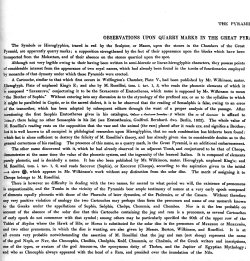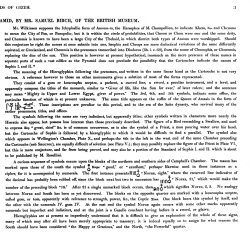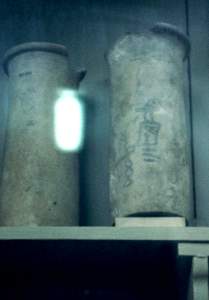

On the last page, I provided conclusive proof that the alleged spelling mistake in the Khufu cartouche does not exist. But I couldn’t help wondering why anybody should think that Vyse was even capable of doing such a thing.
Zecharia Sitchin puts the reader in the picture: Vyse was a real villain, a bad lot, "the black sheep of an English aristocratic family"[1 ].
Sitchin proceeds to describe more details of Vyse’s personality, and how he was eaten up with ambition. In later books, Vyse mutates into a monster who could be guilty of anything, including the murder of Abraham Lincoln. But is this what he was really like?
A book by author and journalist Leonard Cottrell, published in1953, also contains a description of Howard Vyse (1784-1853). Cottrell interviewed descendants of Vyse, including General Sir Richard Howard Vyse (Major-General Sir Richard Granville Hylton Howard-Vyse (1883-1962) – Translator’s note). Cottrell, after mentioning to the reader how the previous Howard Vyse came from a military background, describes how, during the interview, Major-General Howard Vyse told him that his ancestor had been much better at archaeology, and far more interested in it, than he had been in matters military, and it was for this reason that he had been "a trial" to his military family..[2 ]
So the reason why Howard Vyse was a "black sheep" was not because he was a liar, gambler or impostor, but because he preferred "old stones" to the military concerns of his family. Furthermore, continues Cottrell, Howard Vyse was also a very devout man who believed in the literal truth of the Bible; his writings evince a deep sympathy for the builders of the monuments.[3 ]
Peter Tompkins, the main source of many writers on pyramid-related subjects, turns the whole characterisation around:
"Howard Vyse ... was a martinet with little humour. ... A trial to his family, who were pleased to have him away from the country seat ..., even if it cost them some of the family patrimony..."[4 ]
This characterisation seems to be the basis for all later accounts. But, even here, I still cannot see any grounds for the subsequent character-assassinations by Sitchin and other authors.
However, to get back to our main point. According to Sitchin, there is yet more evidence that the inscriptions were forged: an expert opinion from the leading hieroglyphics expert of Vyse’s era, Samuel Birch. Using extracts from Birch’s paper, Sitchin argues that Birch had severe reservations about the authenticity of the inscriptions, because he (Birch) had noticed that the texts were written with signs that were not known in Khufu’s time![5 ].
Sitchin’s summary sounds so plausible that anyone reading it could hardly refrain from wondering how ANY Egyptologist could ever have believed that Vyse had found these hieroglyphs, instead of having put them there in the first place. Let's take a closer look at what Sitchin writes (unfortunately I do not have the English edition, so have had to back-translate from the German one; there might be differences in wording from the original text, but perhaps some kind reader could provide me with the quotes from the English edition):
"At first Birch had doubts about the orthography and the look of the signs. 'The Symbols or Hieroglyphics, traced in red by the Sculptor, or Mason, upon the stone in the Chambers of the Great Pyramid, are apparently quarry marks', he wrote in the first paragraph, directly followed by an evaluation: 'Although not very legible owing to their having been written in semi-hieratic or linear-hieroglyphic characters, they posses points of considerable interest...'
Birch was irritated that signs, that are allegedly, from the beginning of the Fourth Dynasty, characteristic of a form of writing that came in use hundreds of years later. [...] The symbols discovered by Vyse therefore belong to another epoch."[6 ]
Birch’s expert opinion was published in two books: Perring’s "The Pyramids of Gizeh" from 1839, and Vyse’s "Operations carried on...". Would Vyse really have been so stupid as to publish an expert opinion which effectively debunks the hugely important find described in his own book? I think not.
But, as we cannot exclude the possibility, I read the whole Birch paper carefully. Several times. And I could not find proof of ANY of the assertions Sitchin makes. Not a word of concern about the age of the signs. In case readers might like to check for themselves, just klick on the pages from Perring’s book below:


It’s patently obvious that Sitchin has twisted Birch’s message, because Birch was not wondering about the letters, but instead about the fact that there were two cartouche names in the chamber. Not a syllable about different eras - that's a complete falsehood!

|
| Fig. 2 - Hieratic signs on adobe cylinder |
Birch’s concern about the age of the writing seems to be a pure invention on Sitchin’s part. And, besides, there was no reason for Birch to be concerned anyway.
It is true that fully developed hieratic writing did not emerge until about a century after Khufu, but the inscriptions found in his pyramid are not these fully developed signs. The inscriptions in the pyramid are written, as Birch states, in a "semi-hieratic" or "linear-hieroglyphic" style, a precursor of full hieratic script (despite the fact that Sitchin declares the former to post-date even full hieratic - another untruth). Linear writing had existed in Egypt, in parallel with hieroglyphics, since the earliest times; the image on the side is a clay cylinder with semi-hieratic writing from a time about 200 years before Khufu!
So, just to be absolutely clear: like us, the Egyptians used two systems of writing. Hieroglyphics were something like our printed letters, standardised for official use on monuments. And they also had some forms of handwriting, which used a reduced set of signs that were abstract representations of the original hieroglyphs, and could be produced by a quill or a brush. Egyptologist Maria Carmela Betro on this script:
"Hieroglyphic writing’s ability to maintain its expressive pictorial nature until the very end was thanks to the fact that the scribes developed a cursive method of recording the language almost at the very beginning. Cursive was much more quickly written and more practical than the beautiful but laborious hieroglyphs.
"Egyptologists call this script “hieratic” (from the Greek hieratikos, “priestly”) ...
“Semicursive hieroglyphic forms may be found very early, as seen in an inscription painted in kind on a predynastic vase of King Ka. ..."[7 ]
Egyptologist Adelheid Schlott has also considered this subject. Her book Schrift und Schreiber im alten Ägypten [Writing and Writers in Ancient Egypt] contains a list showing how various signs developed over a period of time, from earlier on (3rd dynasty) to the fully developed (5th dynasty) hieratic[8 ]:

Compare the signs in the table with those from the pyramid I showed on the previous page: the style is similar to the one in the "3rd Dynasty" column. The quail (the hieroglyphic on the lower left) is a perfect match for those used in the pyramid.
However, Birch’s "astonishment" wasn’t Sitchin’s only invention. The rest of Sitchin’s chapter about writing is another example of the art of complete fabrication!
Birch had also noticed something else. In Sitchin’s words:[9 ]:
"The hieroglyphics following the cartouche in the same linear writing were interpreted by Birch as a title which means something like "mighty one in upper and lower Egypt." The only similar inscription of this kind 'appears in a title on the coffin of the Queen of Amasis' - from the Saite epoch. He does not bother to explain that pharaoh Amasis .. ruled in the 6th century BC - more than 2000 years after Khufu."
This is yet another out-and-out falsehood, as readers can see for themselves from Birch’s expert opinion. On page 2 [“Ops” I: 283], paragraph 2, he writes:
"The same title appears on the coffin of the Queen of Amasis. ... These inscriptions are peculiar to this period, and to the era of the Saite dynasty, who revived many of the earlier prenomens, titles and offices."
So Birch does not say that the appearance of the inscription on the coffin of the Queen of Amasis was the only one: that's a misinterpretation and over-simplification on Sitchin’s part. Furthermore, Birch does explain the reason for the presence of the inscription: it was because the Saites had revived many of the earlier titles. That Birch "does not bother to explain" is another blatant lie!
What Birch writes about the Saites is accurate. There is a lot of evidence conclusively demonstrating that, in an effort to restore the glory of ancient Egypt, these late period kings, who had succeeded centuries of foreign invaders, revived many ancient traditions and restored numerous ancient temples and pyramids. It is recorded, for example, that, following a hiatus of 2,000 years, they re-introduced the temple ceremonies of the 4th Dynasty kings.
But Sitchin goes further[10 ]:
"Birch also found strange a 'curious sequence of symbols' in the upper chamber ... Here the hieroglyphic of "good, gracious" was used as number - a usage that was never found before or after. This unusual sequence was interpreted as 'eighteenth year' (of the reign of Khufu).”
Now the situation is getting really out of hand! As we have seen in the case of the Isis stele, Sitchin twists the meanings of words. "Cypher" can mean both number, and cipher (code). Birch wrote [“Operations”, I 283 ff] that the symbol Nofre (which meant “good” or “excellent”) was perhaps used as a cipher - a code. And, from Birch’s original text (the paragraph on pages 283-4), it is clear that, by “cipher”, he meant something like a pronome, a code used before the real number. Numbers were written with completely different signs: the Egyptian number signs.
Furthermore, it is impossible to find a single mention of "18th year" anywhere in this expert opinion. Readers can check this in the copies linked above. Contrary to Sitchin’s assertion, Birch interprets the Nofre-sign (which he interprets as "Hoqpe") as a symbol of a cardinal direction, and the digits behind the Nofre glyph as the number of the block in the row. “Nofre" blocks (i.e., blocks bearing a sequence of numerical symbols accompanied by the Nofre symbol) were blocks from the south side. The symbol "gom," or “tom”, the koucoupha sceptre, possibly referring to “strength” or “power” [“Operations”, I 282; 284] appeared on blocks placed on the north side of the chamber – an opinion that was subsequently confirmed, and is still held today.
In other words, the whole story about the so-called “eighteenth year of Khufu” is Sitchin’s invention alone!
The last part of Sitchin’s misrepresentation of sources (impossible to call it anything else) is the fantasy of the two kings. Sitchin claims[11 ], that Birch's expertise had an “explosive” impact, the reason being Birch had found, not just one king's names, but two. And:
"Attempting to analyse the meaning of the ram hieroglyphic, Birch writes: 'A cartouche, similar to the one found in Wellington’s Chamber, has been published by Mr. Wilkinson as an unidentified king ... who reads the phonetic elements of which it is composed as "Seneschufo”, which name is supposed by Mr. Wilkinson to mean "the Brother of Suphis""
The quote in question can be found in the third paragraph of Birch’s page 1 [“Operations” I: 279], and it can clearly be seen that Sitchin significant twists the meaning of the passage by omitting certain segments, but failing to indicate that material has actually been omitted.
Sitchin then spends two pages pondering the possible implications of those two names for his forgery hypothesis, "forgetting" that, in his following line, Birch goes on to say:
"Without entering into any discussion as to the etymology of the prefixed SEN .. it is to be observed that the reading of Sensaophis is false, owing to an error of the transcriber (Wilkinson, rem. FD), which has been adopted by subsequent editors through the want of a proper analysis of the passage."
Hmmm … the reader might recall having seen some use made of this technique already …
However, it is clear that Birch has written the complete opposite of what Sitchin claims! Far from endorsing the interpretation "Brother of Khufu", Birch rejects it. But that doesn’t prevent Sitchin from arguing that the conclusion identified by Birch as mistaken is in fact the right one - even though Birch continues to explain that SEN is a standard pronomen that was incorporated within the cartouche, a customary and - even during Birch's time - well documented, practice.
A complete analysis of Sitchin’s misrepresentation of Birch, and many other facts concerning Sitchin and Vyse, was compiled on Martin Stower’s website, which has unfortunately been off-line for some years now. However, my book "Pyramidengeheimnisse?" (Pyramid Secrets?) contains my own findings on the subject, available in German only.
. So, as far as the question of forgery is concerned, the name of the forger is not Vyse, but Sitchin himself!
| Remarks: | ||
| [1 ] | Sitchin, Stufen, p. 292 | |
| [2 ] | Cottrell, Leonard; The Mountains Pharaoh, p. 128 | |
| [3 ] | ibd. | |
| [4 ] | Tompkins, Peter; Secrets of the Great Pyramid, p. 59 | |
| [5 ] | Sitchin, Stufen p. 298 ff. | |
| [6 ] | ibd. | |
| [7 ] | Betro, Maria Carmela; Hieroglyphics: The Writings of Ancient Egypt, p. 29 ff | |
| [8 ] | Schlott, Adelheid; Schrift und Schreiber im alten Ägypten, p. 78 | |
| [9 ] | Sitchin, Stufen p. 299 | |
| [10 ] | ibd. | |
| [11 ] | ibd. p. 300 f | |